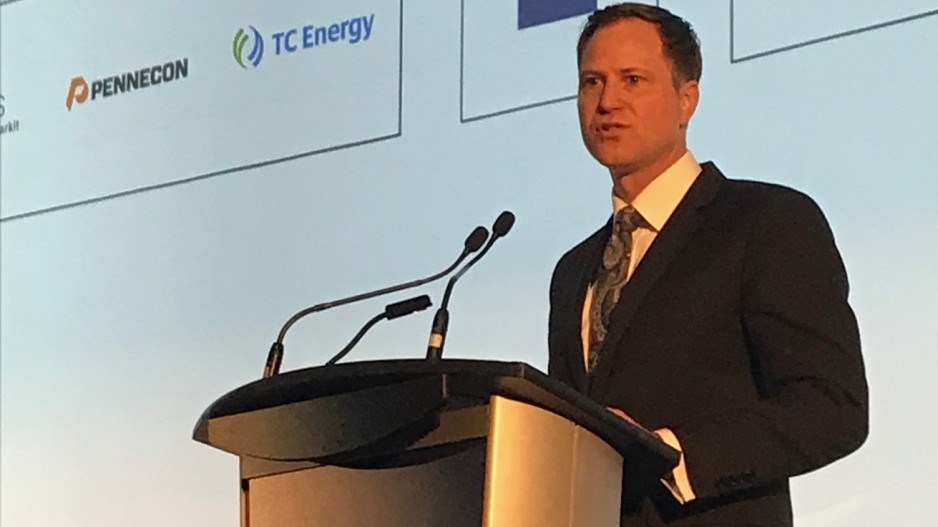Delegates attending the annual Canada Gas and LNG Exhibition Conference in Vancouver Tuesday May 21 were greeted by about two dozen teens, dressed in black, and holding a Canadian flag drenched in what appeared to be oil outside of the Vancouver Convention Centre.
The group, called Sustainabiliteens, were objecting to anything involving fossil fuels – even one that has the potential to actually lower greenhouse gas emissions.
Had they been invited inside, they might have learned that natural gas and liquefied natural gas (LNG) are not only not the same thing as oil, but that there is a net benefit to it, in terms of greenhouse gas reductions, if it replaces coal power.
And because the LNG projects being built or proposed in B.C. would have among the lowest GHG profiles in the world, they might have also learned that LNG produced in B.C. would even avoid emissions produced by LNG plants elsewhere in the world.
Susannah Pierce, director of corporate affairs for LNG Canada - the first large-scale LNG project to be sanctioned in B.C. -- said objecting to LNG on environmental grounds was "cutting off your nose to spite your face."
"And you're making the challenge of climate change more challenging," she said.
“Liquefied natural gas from B.C will have the least CO2 per tonne of any LNG produced in the world,” said Bryan Cox, new CEO for the BC LNG Alliance, during the three-day conference's opening session.
“Not only will B.C. projects have the potential to reduce global emissions by displacing coal, they will also reduce global emissions if they replace LNG produced in other jurisdictions.”
While the $40 billion LNG Canada project is said to have one of the lowest emissions intensities of any large LNG plant, the one proposed by Chevron Canada and Woodside Energy Ltd. -- Kitimat LNG -- would have an even lower emissions intensity.
The joint partnership proposes to build a plant with up to three trains that would produce up to 18 million tonnes of LNG annually.
But the plants would use electric drive, and since the power produced in B.C. is 98% clean energy, mostly from hydro power, it would be "orders of magnitude" lower in emissions in tensity of the large LNG plants either built or proposed for the U.S. Gulf Coast, said Fred Eastwood, manager for Chevron Canada.
"With the use of hydro power...our greenhouse gas footprint is five to eight times lower than best-in-class," Eastwood said.
There would also be fewer emissions associated with transporting the LNG to Asia, since the travel time from B.C. is just 10 days -- about half the time it takes for LNG carriers to travel from the Gulf Coast to Asia.
"The greenhouse gas footprint, and the fuel loss through the value chain, is orders of magnitude lower than the Gulf Coast," Eastwwod.
Some of the natural gas being produced in northeastern B.C. also has a lower carbon footprint, since some of the gas processing plants in the Montney play now run on electricity, rather than natural gas.
“What this means is that a B.C. LNG facility that uses gas-powered turbines will produce literally millions of tonnes less CO2 during its life cycle than a gulf coast plant of similar size," Cox said.
While an LNG industry will increase GHGs in B.C., it will displace GHGs elsewhere, when it displaces coal or even LNG from other countries, Cox said.
“LNG from one large project in B.C., when used to replace a large coal-fired energy facility in Asia, can reduce net GHGs by as much a 67 million tonnes,” Cox said. “That is the equivalent of all B.C.'s GHG emissions in an entire year.”
While the LNG Canada project received a final investment decision last year and is now in early construction, Chevron and Woodside have yet to set a date for FID.
"We don't advertise dates for FID," Eastwood said, adding that there is still work to be done yet ensuring that the economics work.
"There's a lot of work to be done still with governments in terms of investment framework for the projects," he said, referring to both the Kitimat LNG plant and associated Pacific Trails pipeline.
Conspicuously absent at the conference's opening Tuesday were representatives of either the federal or B.C. government. Both levels of government were supposed to speak at the conference, but both were no-shows.
Conference event director Richard MackIntosh told Business in Vancouver that Michelle Mungall, B.C.'s minister of Energy, Mines and Petroleum Resources, spoke at last year's conference, and was invited to speak again this year.
“Unfortunately, she was unavailable,” MackIntosh said.
Roughly 2,500 visitors,delegates and exhibitors are registered for this year's conference – more than twice last year's attendance of 800. All prior conferences in B.C. took place before B.C. actually had an LNG industry. But following a final investment decision last year, the new $40 billion LNG Canada project is now under construction.
Cox said $500 million in contracts have already been awarded in B.C. and an estimated 600 workers are currently employed on the LNG Canada project.




